9.4: India (2 Days)
- Page ID
- 1991
- Outline the basic activities of British colonialism that affected the realm.
- Understand the basic qualities of the rural and urban characteristics of India.
- Summarize the main economic activities and economic conditions in India.
- Describe the differences between various geographic regions of India.
- Explain the measures the Indian government has taken to protect the biodiversity of India.
TEKS Regional Unit 09 South Asia: Chapter 9.4 India
WG.2A Describe the human and physical characteristics of the same regions at different periods of time to evaluate relationships between past events and current conditions.
WG.2B Explain how changes in societies have led to diverse uses of physical features.
WG,4C Explain the influence of climate on the distribution of biomes in different regions.
WG.6B Explain the processes that have caused changes in settlement patterns, including urbanization, transportation, access to and availability of resources, and economic activities.
WG.10D Compare global trade patterns over time and examine the implications of globalization, including outsourcing and free trade zones.
WG.11C Assess how changes in climate, resources, and infrastructure (technology, transportation, and communication) affect the location and patterns of economic activities.
WG.22B Generate summaries, generalizations, and thesis statements supported by evidence.
WG/22C Use geographic terminology correctly.
WG.22D Use standard grammar, spelling, sentence structure, and punctuation.
TEKS and ELPS for Regional World Geography Unit 09--South Asia from TEKS Resource System.
India
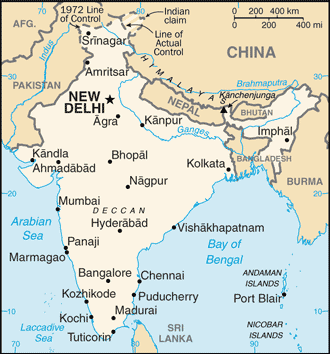 Map of India
Map of IndiaIndia and Colonialism
India is considered the world’s largest democracy. As the historic geography and the development patterns of India are examined, the complexities of this Hindu state surface. European colonizers of South Asia included the Dutch, Portuguese, French, and, finally, the British. In search of raw materials, cheap labor, and expanding markets, Europeans used their advancements in technology to take over and dominate the regional industrial base.
The East India Company was a base of British operations in South Asia and evolved to become the administrative government of the region by 1857. The British government created an administrative structure to govern South Asia. Their centralized government in India employed many Sikhs in positions of the administration to help rule over the largely Muslim and Hindu population. The English language was introduced as a lingua franca for the colonies.
In truth, colonialism did more than establish the current boundaries of South Asia. Besides bringing the region under one central government and providing a lingua franca, India’s colonizers developed the main port cities of Bombay, Calcutta, and Madras (now called Mumbai, Kolkata, and Chennai, respectively. The names of the port cities have been reverted to their original Hindi forms).
The port cities were access points for connecting goods with markets between India and Europe. Mumbai became the largest city and the economic center of India. In 1912, to exploit the interior of India, the British moved their colonial capital from Kolkata, which was the port for the densely populated Ganges River basin, to New Delhi. Chennai was a port access to southern India and the core of the Dravidian ethnic south.
Britain exploited India by extending railroad lines from the three main port cities into the hinterlands, to transport materials from the interior back to the port for export. The Indian Railroad is one of the largest rail networks on Earth. The problem with colonial railroads was that they did not necessarily connect cities with other cities. The British colonizers connected rail lines between the hinterland and the ports for resource exploitation and export of commercial goods. Today, the same port cities act as focal points for the import/export activity of globalization and remain core industrial centers for South Asia. They are now well connected with the other cities of India.
Goa is the smallest state of modern-day India. In the 16th century, it was first encountered by Portuguese traders, who annexed it shortly thereafter to become a colony of Portugal, which it was for the next 450 years. Goa was one of the longest-held colonial possessions in the world and was not annexed by India until 1961. By the mid-1800s, most of the population of this tiny area had been forcibly converted to Christianity.
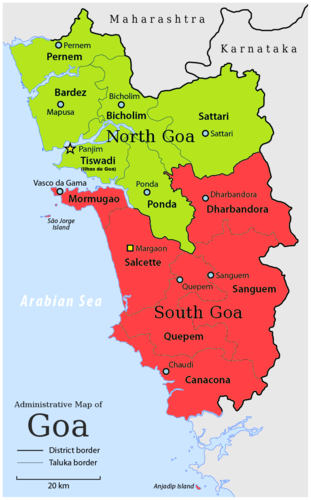 Goa is a state in India within the coastal region known as the Konkan, in Western India. It is bounded by Maharashtra to the north and Karnataka to the east and south, with the Arabian Sea forming its Western coast. It is India's smallest state by area and the fourth smallest by population.
Goa is a state in India within the coastal region known as the Konkan, in Western India. It is bounded by Maharashtra to the north and Karnataka to the east and south, with the Arabian Sea forming its Western coast. It is India's smallest state by area and the fourth smallest by population.Although many Hindu traditions survived the colonial period, and Hindu holidays are celebrated here, Goa is known for its Christian holiday celebrations, especially Christmas and Easter. The cathedral and secular architecture in many of the historic buildings of Goa are European in style, reflecting its Portuguese origins.
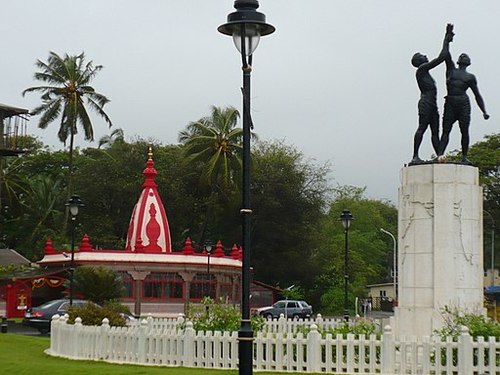 Hindu-Christianity Unity Memorial at Miramar Beach in Goa, India.
Hindu-Christianity Unity Memorial at Miramar Beach in Goa, India.The People of India
Contrasts in India are explicitly evident in the regional differences of its human geography. The north-south contrasts are apparent through the lingua franca and ethnic divisions. The main lingua franca in the north is Hindi. In the Dravidian-dominated south, the main lingua franca is English. The densely populated core region along the Ganges River, anchored on each end by Delhi/New Delhi and Kolkata, has traditionally been called the heartland of India.
The south is anchored by the port city of Chennai and the large city of Bangalore. Chennai has been a traditional industrial center. The industrial infrastructure has shifted to more modern facilities in other cities, giving over to a “rustbelt” syndrome for portions of the Chennai region. India is a dynamic country, with shifts and changes constantly occurring. Any attempt to stereotype India into cultural regions would be problematic.
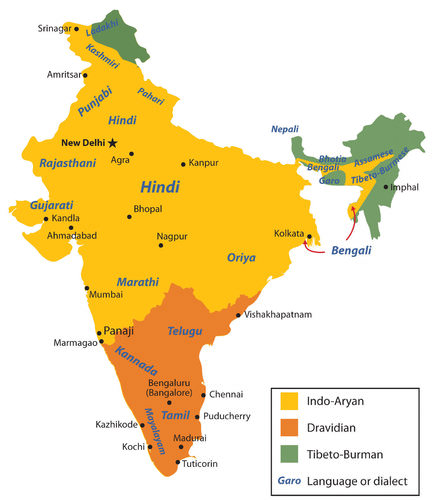 Hindi is the official language of the government, and both Hindi and English are the lingua franca.
Hindi is the official language of the government, and both Hindi and English are the lingua franca.In 2017, India had almost 1.3 billion people, which is about one-sixth of the human population of the earth. An 80 percent majority follow Hindu beliefs. About 13 percent of the population is Muslim. Thirteen may not seem like a high percentage, but in this case it equates to about 140 million people. This is equivalent to all the Muslims who reside in the countries of Iraq, Saudi Arabia, Syria, and Egypt combined. India is sometimes called the third-largest Muslim country in the world, after Indonesia and Pakistan, because of its large Muslim minority.
| Religious group |
Population % 1951 |
Population % 1961 |
Population % 1971 |
Population % 1981 |
Population % 1991 |
Population % 2001 |
Population % 2011 |
|---|---|---|---|---|---|---|---|
| Hinduism | 84.1% | 83.45% | 82.73% | 82.30% | 81.53% | 80.46% | 79.80% |
| Islam | 9.8% | 10.69% | 11.21% | 11.75% | 12.61% | 13.43% | 14.23% |
| Christianity | 2.3% | 2.44% | 2.60% | 2.44% | 2.32% | 2.34% | 2.30% |
| Sikhism | 1.79% | 1.79% | 1.89% | 1.92% | 1.94% | 1.87% | 1.72% |
| Buddhism | 0.74% | 0.74% | 0.70% | 0.70% | 0.77% | 0.77% | 0.70% |
| Jainism | 0.46% | 0.46% | 0.48% | 0.47% | 0.40% | 0.41% | 0.37% |
| Zoroastrianism | 0.13% | 0.09% | 0.09% | 0.09% | 0.08% | 0.06% | n/a |
| Others/Religion not specified | 0.43% | 0.43% | 0.41% | 0.42% | 0.44% | 0.72% | 0.9% |
India essentially has two lingua francas: English and Hindi, of which Hindi is the official language of the Indian government. India has 28 states and 14 recognized major languages. Many different languages are spoken in rural areas. The languages of northern India are mainly based on the Indo-European language family. Languages used in the south are mainly from the Dravidian language family. A few regions that border Tibet in the north use languages from the Sino-Tibetan language family.
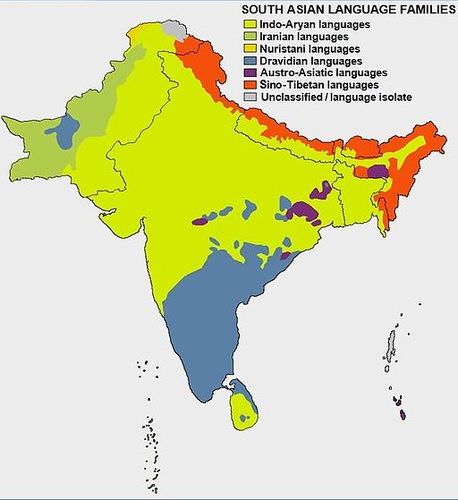 Languages spoken in India belong to several language families, the major ones being the Indo-Aryan languages spoken by 76.5 percent of Indians and the Dravidian languages spoken by 20.5 percent of Indians. Languages spoken by the remaining 3 percent of the population belong to the Austroasiatic, Sino-Tibetan, Tai-Kadai, and a few other minor language families. India has the world's second highest number of languages after Papua New Guinea.
Languages spoken in India belong to several language families, the major ones being the Indo-Aryan languages spoken by 76.5 percent of Indians and the Dravidian languages spoken by 20.5 percent of Indians. Languages spoken by the remaining 3 percent of the population belong to the Austroasiatic, Sino-Tibetan, Tai-Kadai, and a few other minor language families. India has the world's second highest number of languages after Papua New Guinea.| Language | First language speakers |
First language speakers as a percentage of total population |
Second language speakers |
Third language speakers |
Total speakers | Total speakers as a percentage of total population |
|---|---|---|---|---|---|---|
| Hindi | 422,048,642 | 41.03 | 98,207,180 | 31,160,696 | 551,416,518 | 53.60 |
| English | 226,449 | 0.02 | 86,125,221 | 38,993,066 | 125,344,736 | 12.18 |
| Bengali | 83,369,769 | 8.10 | 6,637,222 | 1,108,088 | 91,115,079 | 8.86 |
| Telugu | 74,002,856 | 7.19 | 9,723,626 | 1,266,019 | 84,992,501 | 8.26 |
| Marathi | 71,936,894 | 6.99 | 9,546,414 | 2,701,498 | 84,184,806 | 8.18 |
| Tamil | 60,793,814 | 5.91 | 4,992,253 | 956,335 | 66,742,402 | 6.49 |
| Urdu | 51,536,111 | 5.01 | 6,535,489 | 1,007,912 | 59,079,512 | 5.74 |
| Kannada | 37,924,011 | 3.69 | 11,455,287 | 1,396,428 | 50,775,726 | 4.94 |
| Gujarati | 46,091,617 | 4.48 | 3,476,355 | 703,989 | 50,271,961 | 4.89 |
| Odia | 33,017,446 | 3.21 | 3,272,151 | 319,525 | 36,609,122 | 3.56 |
| Malayalam | 33,066,392 | 3.21 | 499,188 | 195,885 | 33,761,465 | 3.28 |
| Sanskrit | 14,135 | <0.01 | 1,234,931 | 3,742,223 | 4,991,289 | 0.49 |
Urban versus Rural
Rural and urban life within the Indian Subcontinent varies according to wealth and opportunity. While concentrated in specific areas across the landscape, in general the population in rural areas is discontinuous and spread thinly. In urban areas, the populations are very concentrated with many times the population density found in rural areas. India has six world-class cities: Kolkata, Mumbai, Delhi, Chennai, Bangalore, and Hyderabad.
| Rank | City | Population (2011) |
Population (2001) |
State or union territory |
|---|---|---|---|---|
| 1 | Mumbai | 12,442,373 | 11,978,450 | Maharashtra |
| 2 | Delhi | 11,034,555 | 9,879,172 | Delhi |
| 3 | Bangalore | 8,443,675 | 4,301,326 | Karnataka |
| 4 | Hyderabad | 6,993,262 | 3,637,483 | Telangana |
| 5 | Ahmedabad | 5,577,940 | 3,520,085 | Gujarat |
| 6 | Chennai | 4,646,732 | 4,343,645 | Tamil Nadu |
| 7 | Kolkata | 4,496,694 | 4,572,876 | West Bengal |
| 8 | Surat | 4,467,797 | 2,433,835 | Gujarat |
| 9 | Pune | 3,124,458 | 2,538,473 | Maharashtra |
| 10 | Jaipur | 3,046,163 | 2,322,575 | Rajasthan |
| 11 | Lucknow | 2,817,105 | 2,185,927 | Uttar Pradesh |
| 12 | Kanpur | 2,765,348 | 2,551,337 | Uttar Pradesh |
| 13 | Nagpur | 2,405,665 | 2,052,066 | Maharashtra |
| 14 | Visakhapatnam | 2,035,922 | 982,904 | Andhra Pradesh |
| 15 | Indore | 1,960,631 | 1,474,968 | Madhya Pradesh |
| 16 | Thane | 1,818,872 | 1,262,551 | Maharashtra |
| 17 | Bhopal | 1,798,218 | 1,437,354 | Madhya Pradesh |
| 18 | Pimpri-Chinchwad | 1,729,359 | 1,012,472 | Maharashtra |
| 19 | Patna | 1,683,200 | 1,366,444 | Bihar |
| 20 | Vadodara | 1,666,703 | 1,306,227 | Gujarat |
| 21 | Ghaziabad | 1,636,068 | 968,256 | Uttar Pradesh |
| 22 | Ludhiana | 1,613,878 | 1,398,467 | Punjab |
| 23 | Coimbatore | 1,601,438 | 930,882 | Tamil Nadu |
| 24 | Agra | 1,585,704 | 1,275,134 | Uttar Pradesh |
| 25 | Madurai | 1,561,129 | 928,869 | Tamil Nadu |
India’s interior is mainly composed of villages. In rural villages, much of the economy is based on subsistence strategies, primarily agriculture and small cottage industries. The lifestyle is focused on the agricultural cycles of soil preparation, sowing, and harvesting as well as tending animals, particularly water buffalo, cattle, goats, and sheep. About 65 percent of the population lives in rural areas and makes a living in agriculture.
About 35 percent of the population—which is equal to the entire US population—is urbanized. India is rapidly progressing toward urbanization and industrialization. Changes in technology, however, tend to be slow in dispersing to the rural villages. More than half the villages in India do not have road access for motor vehicles. For residents of those villages, walking, animal carts, and trains are the main methods of transportation. Agricultural technology is primitive. Diffusion of new ideas, products, or methods can be slow. Modern communication technology is helping connect these remote regions.
 Plowing the field the traditional way in Manthralaya, AP, India.
Plowing the field the traditional way in Manthralaya, AP, India.India’s cities are dynamic places, with millions of people, cars, buses, and trucks all found in the streets. In many areas of urban centers, traffic may be stopped to await the movement of a sacred cow or a donkey or bullock cart loaded with merchandise. Indian cities are growing at an unsustainable rate. Overcrowded and congested, the main cities are modernizing and trying to keep up with global trends.
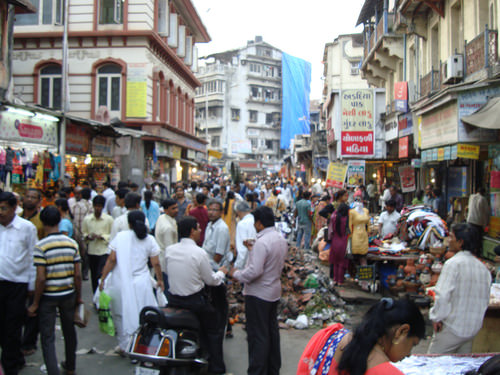 A crowd of people on a street in Mumbai, India.
A crowd of people on a street in Mumbai, India. Traditionally, family size was large. Large family size results in a swell of young people migrating to urban areas to seek greater opportunities and advantages. In modern times, family size has been reduced to about three children, an accomplishment that did not come easily because of the religious beliefs of most of India’s people. If current trends continue, India will overtake China as the most populous country in the world in about 50 years.
India's Population Pyramid
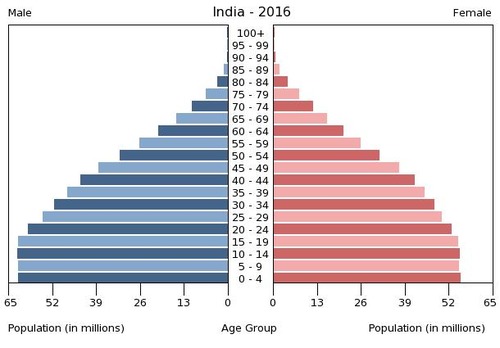 Age Structure of India: 0-14 years: 27.34 percent (male 186,087,665/female 164,398,204); 15-24 years: 17.9 percent (male 121,879,786/female 107,583,437); 25-54 years: 41.08 percent (male 271,744,709/female 254,834,569); 55-64 years: 7.45 percent (male 47,846,122/female 47,632,532); 65 years and over: 6.24 percent (male 37,837,801/female 42,091,086)
Age Structure of India: 0-14 years: 27.34 percent (male 186,087,665/female 164,398,204); 15-24 years: 17.9 percent (male 121,879,786/female 107,583,437); 25-54 years: 41.08 percent (male 271,744,709/female 254,834,569); 55-64 years: 7.45 percent (male 47,846,122/female 47,632,532); 65 years and over: 6.24 percent (male 37,837,801/female 42,091,086)The level of official governmental control is usually different in an urban setting from what it is in the rural areas. There may be more police or military personnel in areas of heavy traffic or in urban areas that need extra control. A central feature of many Indian cities is an older central city that represents the protected part of the city.
In Delhi, for example, New Delhi represents the new construction of government buildings that was begun during the British occupation of the region as part of the British Empire. Old Delhi represents the old markets, government buildings, palaces, fortresses, and mosques that were built during the Mogul Empire, between the mid-1500s and the mid-1800s.
 The front view of National Museum New Delhi India.
The front view of National Museum New Delhi India. These older parts of the cities, particularly the markets, are bustling with activities, merchants, shoppers, cab drivers, and pedal and motor rickshaws. Rickshaws are either bicycle-driven cabs or cabs based on enclosed motor scooters.
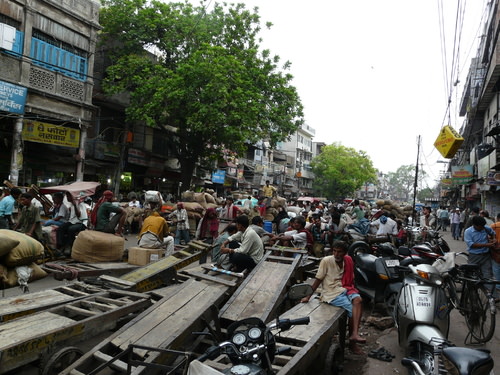 Carts parked on the spice market, Khari Baoli Road in Old Delhi, India.
Carts parked on the spice market, Khari Baoli Road in Old Delhi, India.In urban areas, there is a socioeconomic hierarchy of a small group of people who are wealthy and can afford all the amenities we associate with modern life—electricity, clean water, television, computers, and the like. One of the things that characterize modern Indian cities is an expanding middle class. Many young people see the kinds of material goods that are available in the West and are creating job markets and opportunities to allow them to reach or maintain this type of lifestyle. One of the major markets to support this burgeoning middle class is the information technology field, as well as outsourcing in many of the cities of peninsular India.
India is a country with considerable contrast between the wealthy urban elites and the poor rural villagers, many of whom move to the cities and live in slums and work for little pay. Low labor costs have enabled Indian cities to industrialize in many ways similar to Western cities, complete with computers, Internet services, and other modern communications services.
India’s growing middle class is a product of educational opportunities and technological advancements. This available skilled labor base has allowed India’s industrial and information sectors to take advantage of economic opportunities in the global marketplace to grow and expand their activities. Development within India is augmented by outsourcing activities by American and European corporations to India. Service center jobs created by business process outsourcing (BPO) are in high demand by skilled Indian workers.
India’s Economic Situation
In the past decade, India has possessed the second fastest growing economy in the world, after China. India’s economy continues to rapidly expand and have a tremendous impact on the world economy. In spite of the size of the economy, India’s population has a low average per capita income. Approximately one-fourth of the people living in India live in poverty. The World Bank classifies India as a low-income economy.
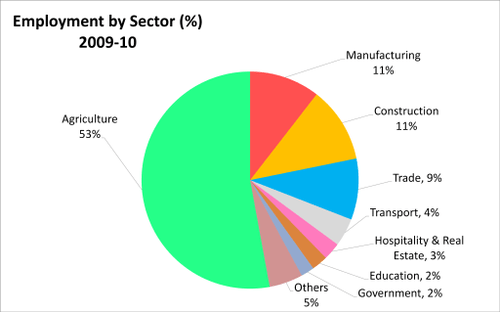 This chart shows the distribution of labor among India's official major economic categories.
This chart shows the distribution of labor among India's official major economic categories.India has followed a central economic model for most of its development since it declared independence. The central government has exerted strict control over private sector economic development, foreign trade, and foreign investment. Through various economic reforms since the 1990s, India is beginning to open up these markets by reducing government control on foreign investment and trade. Many publicly owned businesses are being privatized. Globalization efforts have been vigorous in India. There has been substantial growth in information services, health care, and the industrial sector
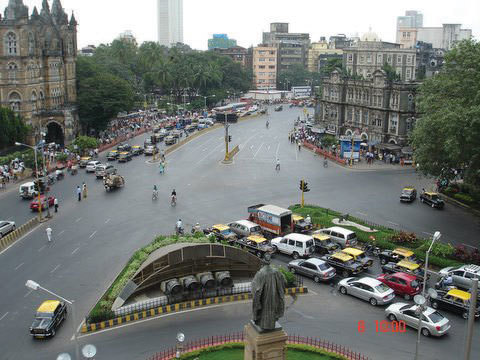 Mumbai is the entertainment, fashion and commercial center of India.
Mumbai is the entertainment, fashion and commercial center of India.The economy is extremely diverse and has focused on agriculture, handicrafts, textiles, manufacturing, some industry, and a vast number of services. A 60 percent majority of the population earns its income directly from agriculture and agriculture-related services. Land holdings by individual farmers are small, often less than five acres. When combined with the inadequate use of modern farming technologies, small land holdings become inadequately productive and impractical.
Monsoons are critical for the success of India’s agricultural crops during any given season. Because the rainfall of many agricultural areas is tied to the monsoon rains of only a few months, a weak or delayed rainfall can have disastrous effects on the agricultural economy. Agricultural products include commercial crops such as coffee and a variety of spices. An essential product for perfume and incense is sandalwood, harvested primarily in the dense forests of the state of Karnataka, in southwestern India. Bamboo, rice, and lentils provide an important basis for the local economy as well.
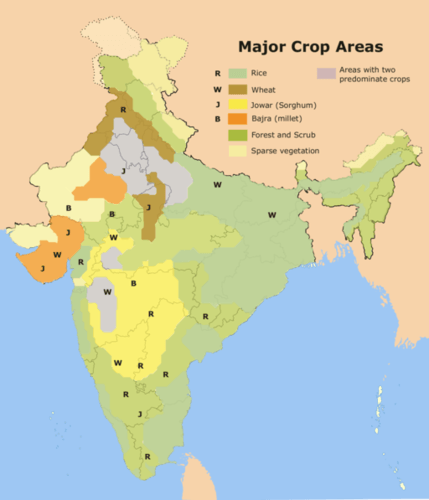 The history of Agriculture in India dates back to Indus Valley Civilization Era and even before that in some parts of Southern India.
The history of Agriculture in India dates back to Indus Valley Civilization Era and even before that in some parts of Southern India. Over the last two decades, information technology and related services are transforming India’s economy and society. In turn, India is transforming the world’s information technologies in terms of production and service as well as the export of skilled workers in financial, computer hardware, software engineering, and software services. Manufacturing and industry are becoming a more important part of India’s economy as it begins to expand.
Manufacturing and industry account for almost one-third of the gross domestic product (GDP) and contribute jobs to almost one-fifth of the total workforce. Major economic sectors such as manufacturing, industry, biotechnology, telecommunications, aviation, shipbuilding, and retail are exhibiting strong growth rates.
A large number of educated young people who are fluent in English are changing India into a “back office” target for global outsourcing for customer services. These customer services focus on computer-related products but also include service-related industries and online sales companies. The level of outsourcing of information activity to India has been substantial.
Any work that can be conducted over the Internet or telephone can be outsourced to anywhere in the world that has high-speed communication links. Countries that are attractive to BPO are countries where the English language is prominent, where employment costs are low, and where there is an adequate labor base of skilled or educated workers that can be trained in the services required. India has been the main destination for BPO activity from the United States. Firms with service work or computer programming are drawn to India because English is a lingua franca and India has an adequate skilled labor base to draw from.
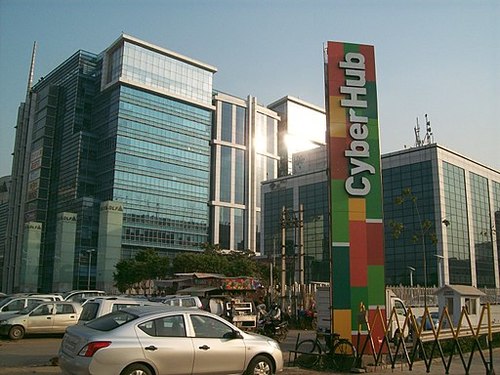 About 2.8 million people work in outsourcing sector in India.
About 2.8 million people work in outsourcing sector in India.Tourism has always been an important part of India’s economy and has been focused on the unique natural environments as well as historical cities, monuments, and temples found throughout the country. Of particular importance are the Mogul-period tombs, palaces, and mosques in Delhi, Agra, and Jaipur, India’s “Golden Triangle” of tourism.
India is a country of contrasts. Scenic beauty abounds from the Eastern and Western Ghats to the high mountains of the Himalayas. The monsoon rains provide abundant agricultural crops for densely populated regions such as the Ganges River basin. On the other hand, places such as the Thar Desert are sparsely inhabited.
There is a wide gap between the wealthy elite and the massive numbers of people who live in poverty. Mumbai has some of the largest slums in Asia, yet it is the financial capital of India, teeming with economic activity. As incomes rise for the middle class in India, the price of automobiles becomes more accessible. On the downside, an escalation in the numbers of motor vehicles in use tends to lead to an escalation in the levels of air pollution and traffic congestion.
Similarly, an expansion of transportation systems increases the use of fossil fuels. India is a major competitor for fossil fuels exported from the Persian Gulf and other Organization of Petroleum Exporting Countries (OPEC) sources. The continued industrialization and urbanization in India foretell an increase in demand for energy. Rising energy costs and demand, combined with economic growth, have caused a serious problem for India.
Many areas will be without power as they are shut off the power grid for hours or days, a process known as load-shedding. This allows industry and manufacturing to use energy resources during peak times. In general, India is poor in natural gas and oil resources and is heavily dependent on coal and foreign oil imports. India is rich in alternative energy resources, such as solar, wind, and biofuels. However, alternative energy resources have not been sufficiently developed.
Vehicle Manufacturing
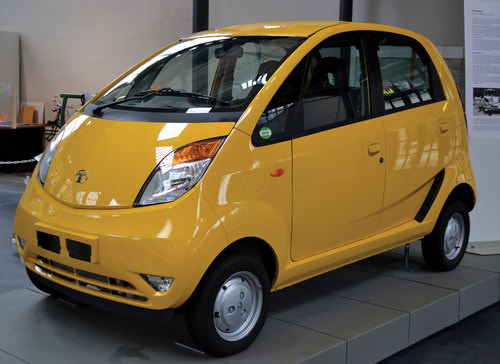 The Nano is considered the world’s most inexpensive car.
The Nano is considered the world’s most inexpensive car.An example of India’s growing economic milieu is motor vehicle manufacturing. India’s vehicle manufacturing base is expanding rapidly. Vehicle manufacturing companies from North America, Europe, and East Asia are all active in India, and India also has its own share of vehicle manufacturing companies. For example, Mumbai-based Tata Motors Ltd. is the country’s foremost vehicle production corporation and it claims to be the second-largest commercial vehicle manufacturer in the world.
Tata Motors is India’s largest designer and manufacturer of commercial buses and trucks, and it also produces the most inexpensive car in the world, the Tata Nano. Tata Motors manufactures mid-sized and larger automobiles, too. The company has expanded operations to Spain, Thailand, South Korea, and the United Kingdom. The company is an example of an Indian-based international corporation that is a force in the global marketplace. In 2010, India was recognized as a major competitor with Thailand, South Korea, and Japan as the fourth main exporter of autos in Asia.
The Indian Cinema
Cinema makes up a large portion of the entertainment sector in India. India’s cinema industry is often referred to as “Bollywood,” a combination of Bombay and Hollywood. Technically, Bollywood is only the segment of the Indian cinema that is based out of Bombay (Mumbai), but the title is sometimes misleadingly used to refer to the entire movie industry in India.
Bollywood is the leading movie maker in India and has a world-class film production center. In the past few years, India has been producing as many as one thousand films annually. The highest annual output for the US film industry is only about two-thirds of what India produces. According to the Guinness Book of World Records, India’s city of Hyderabad has the most extensive film production center in the world. The Telugu film industry operates the studio in Hyderabad.
.jpg?revision=1) Bollywood actresses in Mumbai.
Bollywood actresses in Mumbai.Indian films are produced in more than a dozen languages and appeal to a wide domestic and international audience. Indian movies range from long epic productions with stories within stories to dramas, musicals, and theatrical presentations. Their popularity extends beyond South Asia. Indian movies with modest dress, lack of explicit sexual scenes, and a focus on drama are popular in places such as Egypt, the Middle East, and other African countries.
Movie stars are energetically promoted and enjoy celebrity in India, as is the case with the entertainment industry in the United States and Europe. The cinema is part of the cultural experience in Indian society. Urban life in India reserves a large presence for the entertainment industry, particularly the Indian film industry. One of the prime artistic endeavors in urban India is movie posters depicting all the glory of the latest Bollywood movie. Most of these colorful posters are painted by hand and they tend to be large. Some are several stories high.
India: East and West
India makes up the largest physical area of the South Asia realm. Another way of looking at the physical and human landscapes of India is to study spatial characteristics. Additionally, the economic side of the equation can be illustrated by dividing India between east and west according to economic development patterns. To do this, on a map of India draw an imaginary line from the border with Nepal in the north, near Kanpur, to the Polk Strait border with Sri Lanka in the south. This division of India illustrates two sides of India’s economic pattern: an economically progressive West India and an economically stagnant East India.
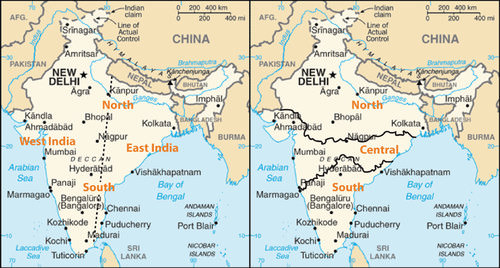 India can be divided either along north/south dimensions or along east/west dimensions.
India can be divided either along north/south dimensions or along east/west dimensions. The progressive western side of India is anchored by Mumbai and its surrounding industrial community. Mumbai is the economic giant of India with the country’s main financial markets. It has been a magnet for high-tech firms and manufacturing. Mumbai’s port provides access to global markets and is connected to international trade networks. Auto manufacturing, the film industry, and computer firms all have major centers in the large urban metropolitan areas of the west.
Large industrial cities such as Bangalore and Hyderabad have established themselves as high-tech production centers, attracting international business in the computer industry and the information sector. Chemical processing has been ongoing in Bhopal, which is noted for an environmental disaster, a gas leak in 1984 that resulted in the deaths of as many as 10,000 people.
The nation’s capital is located in New Delhi, which borders the massive city of (Old) Delhi. The western half of India has been progressing along a pattern with a positive economic outlook that views the global community outside of India as a partner in its success.
The eastern half of India has not been as prosperous as the west in its economic growth. The renowned city of Kolkata has traditionally anchored the eastern sector, but its factories have deteriorated into rustbelt status with aging and outdated heavy industries. The high-intensity labor activities of textile and domestic goods manufacturing are not as economically viable as they were in the past.
The stagnant economic scene in the east is signified by the low average income levels of many of the states in the eastern region. Neighboring Bangladesh offers little in support of economic growth, and Myanmar, another neighbor to the east, has its own set of problems and lacks support for East India. The eastern half of India does not have strong partnerships with the global economy found in the west and thus relies more on internal resources for survival.
India: North and South
There are differences in the geographic patterns between the northern and southern halves of India as well as between the eastern and western halves—depending on the criteria used to compare them. Climate patterns, for example, are more diverse in the north, with a wide range of temperatures throughout the seasons. Winter temperatures in the mountainous north are cold and summer temperatures in the Thar Desert can be extremely high.
Southern India has a more moderate range of temperatures throughout the year. The far north has high mountains. The south has only the low-lying Eastern and Western Ghats. The north has the extensive Ganges River basin. The south has different drainage networks based on the plateaus of the region.
Besides the physical aspects, there are cultural differences between the north and south as well. India is a complex societal mix of many ethnic groups, languages, and traditions. There are some recognizable trends that have been commonly stated between the northern and southern parts of India. The north is portrayed as a competitive, faster-paced society. The south has been portrayed as more relaxed and less competitive.
Indo-European languages are mainly spoken in the north and Dravidian languages are predominantly spoken in the south. Hindi is more commonly the lingua franca of the north, while English is more frequently the lingua franca of the south. People in the north are of Indo-Aryan descent, while the people in the south have a Dravidian heritage. Hinduism dominates all of India, but the north has a wider diversity of religions, such as Sikhism, Buddhism, and Islam, practiced by a large number of people. The south has a substantial Christian population along its west coast.
Food is an important part of the culture of societies, and there are clear distinctions between the cuisine of the north and of the south in India. Indian cooking is primarily vegetarian, emphasizing aspects of Hinduism. However, many dishes, particularly in North India, contain goat, chicken, lamb, fish, and other meats. Beef is not eaten by Hindus, while pork and some species of fish are not traditionally eaten by Muslims.
North India has more wheat-based products and less rice. Their dishes are prepared with spices and herbs, including chili peppers. Northern Indian food is characterized by its use of dairy products, such as yogurt, milk, homemade cheeses, and clarified butter. Onions, ghee, and spices are the common base for different types of curries. Griddles are used for preparing different types of flat bread, like chapattis, naan, and kulcha. Rice, lentils, and chickpeas are a staple part of the diet in North India.
 North Indian cuisine is a part of Indian cuisine, from the region of Northern India which includes the Pakistani provinces. This dish is called Boondi Ka Laddu.
North Indian cuisine is a part of Indian cuisine, from the region of Northern India which includes the Pakistani provinces. This dish is called Boondi Ka Laddu.Food in the southern parts of India includes more rice as a staple, and seafood is common along the coastal areas. Coconut oil is used as a basis for cooking. Sambar, a stew made of peas and vegetables, is an important staple of the region. Rice and idlis (a type of cake or bread made from steaming fermented black lentils) is a staple in the cuisine as well. Chili peppers are also common in South Indian cooking.
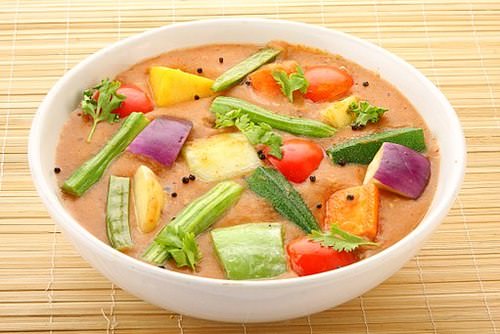 Sambar is a lentil-based vegetable stew or chowder popular in South Indian cuisine.
Sambar is a lentil-based vegetable stew or chowder popular in South Indian cuisine.Biodiversity and the Environment
Because of population growth and resource depletion, India struggles with major environmental problems. Water pollution along the Ganges is severe and affects the largest concentration of people in India. India is the second-largest consumer of coal in the world, coal that is mainly burned to produce electricity. Burning coal adds significantly to air pollution. A rise in the number of vehicles in use, combined with few emission controls, destroys the air quality. Deforestation also adds to the issues of environmental degradation in India.
India has a number of rare animal species that need habitat if they are going to survive. A few of the larger animals include the Indian Rhinoceros, Clouded Leopard, Indian Leopard, Snow Leopard, Asiatic Lion, Bengal Tiger, Asian Water Buffalo, Asian Elephant, Striped Hyena, and the Red Panda. Many species are endangered or threatened along with many other lesser-known organisms. The high human population growth throughout South Asia places a strain on the natural habitat of wild animals. Habitat loss caused by human development makes holding on to the wide array of biodiversity difficult.
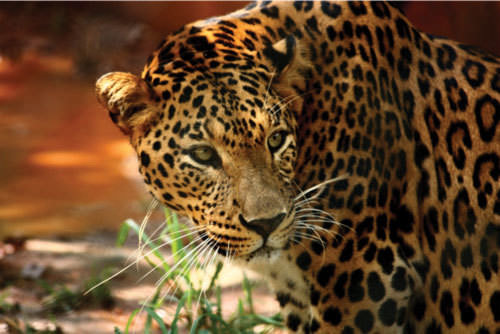 The Indian Leopard is a near-threatened species that once lived throughout South Asia.
The Indian Leopard is a near-threatened species that once lived throughout South Asia. India has instituted measures designed to preserve its biodiversity. The Indian government has created sanctuaries for threatened or endangered species. National parks were established before India declared independence and were substantially expanded in recent decades. In 1972, The Wildlife Protection Act was instituted to create critical habitat for tigers and other rare species. There are hundreds of protected wildlife areas and 15 biosphere reserves in India. Four of the biospheres were created in conjunction with the World Network of Biosphere Reserves.
The Indian government has established protected areas throughout the country, many of which are in the highland regions and the northern mountains. For example, the Gir Wildlife Sanctuary, including an area preserved for Asian Lions, is located on the Kathiawar Peninsula north of Mumbai, which juts out into the Arabian Sea. India is the only place left with Asian Lions in the wild. Tigers, elephants, rhinos, and leopards can be found in the sanctuaries.
The country has about 92 national parks, which are also home to rare wildlife species, and more than 350 wildlife sanctuaries of all sizes. There are about 28 tiger reserves in India. The country also has a number of marine reserves and protected areas along its coastlines.
The efforts of the Indian government to protect the country’s biodiversity constitute an admirable environmental undertaking. The government has stepped up law enforcement efforts to combat poaching, which is a major cause of the decrease in numbers of rare species. Poachers kill animals such as tigers, leopards, elephants, and rhinos for their hides, horns, or body parts, which are sold on the black market in Asia for large sums of money.
Many of the rare, threatened, or endangered species of India would not have a chance of survival without the government efforts to protect and provide for them. Balancing finding resources for rapid human population growth with wildlife management will continue to be a challenge in the years ahead for India and all countries of the planet
- Colonialism had a tremendous impact on South Asia and its people. Colonial development patterns were implemented to control the people and to extract resources, not necessarily to benefit the realm.
- India has a wide disparity between its poor rural areas with agricultural economies and its wealthier bustling cities with expanding business sectors.
- Various urban centers of India have positioned themselves well to take advantage of the global economy and expand their manufacturing and industrial base. India is becoming a major manufacturing country for vehicles and high-tech industries.
- There are noticeable economic differences between the more progressive Western India and the stagnant economic conditions of Eastern India. There is also a noticeable cultural difference between the North and the South in India in the categories of language, ethnicity, food, and society.
- The Indian government has created national parks, wildlife sanctuaries, and game reserves to help protect rare, threatened, or endangered species.
Vocabulary Terms
|
Aryan |
a member of an Indo-European people who crossed into India around 1500 B.C. |
|
The religious and moral duties of the Hindus |
|
|
Ancient Indian culture, dating back to 2500 B.C., that included the people of the entire Indus River region |
|
|
To focus the mind inward in order to find spiritual awareness |
|
|
To move from one place to settle in another |
|
|
A person who spreads his or her religious beliefs to others |
|
|
A leader who used nonviolence to oppose the British rule of India |
|
|
A strong wind that blows across East Asia at certain times of the year |
|
|
The lasting peace that Buddhist seek by giving up selfish desires |
|
|
Siddhartha Gautama |
an Indian prince who founded Buddhism; also known as Buddha. |
|
A large landmass that juts out from a continent |
Applying Knowledge
Discussion and Study Questions
- Outline the main ways in which British colonialism impacted South Asia.
- What are the three main language families in India? What is the lingua franca?
- List the main qualities that are different between the rural and urban areas of India.
- How did British colonizers transport resources from the hinterland to the port cities for export back to Great Britain? How has this system changed since 1947?
- Explain the various ways in which the rapid population growth is impacting India.
- Why is India a major target for BPO?
- List various ways the Indian film industry impacts India and the world.
- How is economic development different between Western India and Eastern India?
- Outline some cultural differences between the North and the South in India.
- How has the government of India worked to protect the biodiversity of the natural environment? What are some of the animals that are being protected?
Real-World Geography Exercise
- Using Google Maps, complete the following activities:
- Locate each place on the bulleted list below.
- Find the nearest city with an international airport in proximity to each location on the bulleted list below.
- Calculate the distance and travel time by plane to each city from the Phoenix Sky Harbor International Airport in Phoenix, Arizona.
- Using NASA Latitude and Longitude Finder, determine the latitude and longitude for each location on the bulleted list below.
- Be prepared to share and discuss your answers.
- Agra
- Bangalore
- Bombay (Mumbai)
- Bhopal
- Calcutta (Kolkata)
- Delhi
- Goa
- Hyderabad
- Jaipur
- Kathiawar Peninsula
- Madras (Chennai)
- New Delhi
Current Events
The Influence of Indian Languages On English
Why Gold Is Still the Preferred Investment Option for Indians?
Mumbai: What India's Landmark LGBT Ruling Means for Bollywood
Videos for Geography Enrichment
Helpful Websites for the Study of Geography
Canadian Encyclopedia is an encyclopedia funded by the Canadian government covering all branches of knowledge. Their scholarly collection includes interactive materials.
CIA World Factbook provides information on the people, history, government, economy, energy, geography, communications, transportation, military, and transnational issues for the world's entities.
Congress.gov is a US government website where you can find federal legislation, past and present, as well as information about the US legal system.
Drug Enforcement Administration (DEA) is a government agency website that provides current news, resources, topics of interest, information about drugs, careers in the DEA, and a tip hotline.
Library of Congress is the largest library in the world and provides manuscripts, files, information, pictures, and videos.
NASA Earth Observatory (NEO) is a US government agency website that allows users to search for and retrieve satellite images of Earth.
National Archives is a US government website that provides historical documents, photos, records, publications, and educator resources.
National Oceanic and Atmospheric Association (NOAA) is a US government agency website that provides weather-related information and ocean research.
National Map is a website by the United States Geological Survey and other federal, state, and local agencies that delivers topographic information for the United States.
NationMaster is a massive central data source and a handy way to graphically compare nations.
Real-Time World Air Quality Index is a website that measures most locations in the world for air pollution in real time.
StateMaster is a unique statistical database, which allows you to research and compare a multitude of different data on US states.
United Nations (UN) is an international organization founded in 1945 and made up of 193 member states. The UN maintains international peace and security, protects human rights, delivers humanitarian aid, promotes sustainable development, and upholds international law.
United States Census Bureau is a US government agency that provides a population clock, data, surveys, statistics, a library with information and infographics, news about the economy, and much more.
United States Geological Survey (USGS) is a US government agency website that provides scientific information about the natural hazards that threaten lives, the natural resources we rely on, the health of our ecosystems and environment, and the impacts of climate and land-use change.
Whitehouse.gov is a US government website that provides the latest presidential news, information about the budget, policy, defense, and many more topics.
World Health Organization (WHO) is under the United Nations and provides leadership on matters critical to health, shapes the research agenda on health, and monitors the health situation and assessing health trends around the world. Their website provides information on the state of health around the world, outbreaks, current health news, and more.
World Trade Organization (WTO) is an intergovernmental organization that regulates international trade. The website provides information on the history of the multilateral trading system, featured videos, news and events, trade topics, and more.

